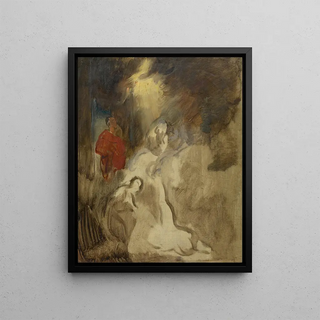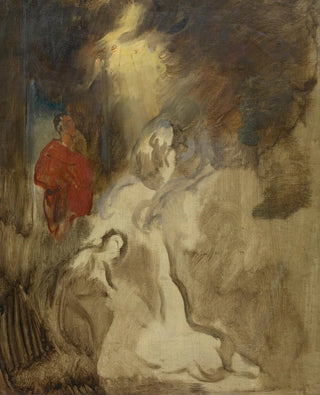Art print | Sketch of the martyrdom of Saint Hippolytus - Hans Canon


View from behind

Frame (optional)
The artwork "Sketch of the Martyrdom of Saint Hippolyte" by Hans Canon is a creation that immerses the viewer in an atmosphere filled with emotion and spirituality. This painting, which depicts a tragic episode from the saint's life, highlights the struggle between faith and persecution. Through this sketch, Canon manages to capture the very essence of martyrdom, a recurring theme in religious art, while infusing it with a personal touch that makes the scene all the more poignant. The depiction of the martyr, both heroic and vulnerable, invites reflection on suffering and sacrifice—universal elements that still resonate today.
Style and uniqueness of the work
Hans Canon's style is distinguished by remarkable technical mastery, combined with an artistic sensitivity that transcends mere visual representation. In "Sketch of the Martyrdom of Saint Hippolyte," the colors are carefully chosen, oscillating between dark tones and luminous highlights that emphasize the drama of the scene. The expressions of the characters, especially that of the saint, are charged with emotional intensity that captures attention and evokes empathy. The composition is thoughtfully arranged, with each element positioned to guide the viewer's gaze toward the focal point of the artwork. This ability to orchestrate visual elements with harmony and depth reflects Canon's originality, blending tradition and innovation in his artistic approach.
The artist and his influence
Hans Canon, a Flemish painter from the 16th century, is an emblematic figure of the Renaissance. His career, marked by an relentless pursuit of perfection, led him to explore various themes, from portraits to religious scenes. Canon's influence extends beyond his personal production, as he also played a crucial role in transmitting the artistic techniques of his time. By integrating elements of Italian painting into his own style, he created a unique visual language that inspired many contemporary and later artists. His work "Sketch of the Martyrdom of Saint Hippolyte" perfectly illustrates this stylistic hybridization, where the

Matte finish

View from behind

Frame (optional)
The artwork "Sketch of the Martyrdom of Saint Hippolyte" by Hans Canon is a creation that immerses the viewer in an atmosphere filled with emotion and spirituality. This painting, which depicts a tragic episode from the saint's life, highlights the struggle between faith and persecution. Through this sketch, Canon manages to capture the very essence of martyrdom, a recurring theme in religious art, while infusing it with a personal touch that makes the scene all the more poignant. The depiction of the martyr, both heroic and vulnerable, invites reflection on suffering and sacrifice—universal elements that still resonate today.
Style and uniqueness of the work
Hans Canon's style is distinguished by remarkable technical mastery, combined with an artistic sensitivity that transcends mere visual representation. In "Sketch of the Martyrdom of Saint Hippolyte," the colors are carefully chosen, oscillating between dark tones and luminous highlights that emphasize the drama of the scene. The expressions of the characters, especially that of the saint, are charged with emotional intensity that captures attention and evokes empathy. The composition is thoughtfully arranged, with each element positioned to guide the viewer's gaze toward the focal point of the artwork. This ability to orchestrate visual elements with harmony and depth reflects Canon's originality, blending tradition and innovation in his artistic approach.
The artist and his influence
Hans Canon, a Flemish painter from the 16th century, is an emblematic figure of the Renaissance. His career, marked by an relentless pursuit of perfection, led him to explore various themes, from portraits to religious scenes. Canon's influence extends beyond his personal production, as he also played a crucial role in transmitting the artistic techniques of his time. By integrating elements of Italian painting into his own style, he created a unique visual language that inspired many contemporary and later artists. His work "Sketch of the Martyrdom of Saint Hippolyte" perfectly illustrates this stylistic hybridization, where the






